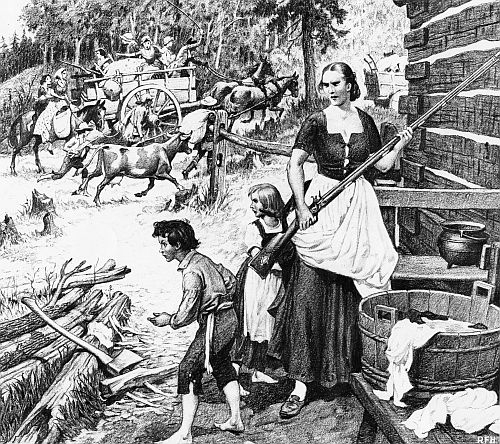 (Host) As part of VPR’s recognition of Women’s History Month,
(Host) As part of VPR’s recognition of Women’s History Month,
commentator and historian Jill Mudgett – who writes about cultural,
environmental, and regional topics from her home in Lamoille County –
considers how the public story of Vermont pioneer Ann Story was
invented, expanded, and has changed over time.
(Mudgett)
Vermont historians have been talking about the pioneer Ann Story for
200 years now, and the narrative hasn’t changed very much. Ann came to
the Vermont wilderness as a widow with young children. She built a cabin
in the Salisbury woods. She remarried twice and died an elderly woman.
We talk about these things, of course, but mostly we talk about her
ruggedness and her manly strength and bravery as she defended her family
and home from Tories and Indians. Sometimes we talk about her role as a
spy or informant for the Green Mountain Boys. More than anything,
though, we talk about the earthen cave that she and a male settler dug
into a bank along the Otter Creek, the cave where her family spent the
night when it seemed unsafe to stay in their cabin. The cave is no
longer visible along the creek bank, but the story of the family in the
cave is exotic, filled with adventure, and totally beyond the normal
realities of our own lives. It never loses its appeal.
Most of
what we know about Ann Story and her cave comes from an author named D.
P. Thompson, whose 1839 novel the Green Mountain Boys drew inspiration
from writers like James Fenimore Cooper. It’s offered generations of
readers a Vermont wilderness full of romance and populated by men and
women who were hardy, clever, and fearless.
 Earlier accounts
Earlier accounts
were less romantic. In 1814 – three years before Ann’s death – a man
named Josiah Dunham solicited Vermont town histories for material for a
book that was never published. First settlers mattered to nineteenth
century town historians. In Salisbury ‘s response, there isn’t much in
the way of revolutionary intrigue but there is an account in which a
woman called "Widow Story" and her children were Salisbury ‘s first
settlers. We’re told that life in early Vermont wasn’t easy for her and
that she worked really hard at chores generally assigned to men. The
account isn’t exactly romantic, but simple, inclusive, and
matter-of-fact.
What I like best about it is how it segues
directly from Ann Story to the second woman in town. A woman referred to
as Mrs. Waterhouse – along with her husband and children – lived for a
time with the Storys in their log home. At one point the little cabin
sheltered 21 people. Although I wish we were told Mrs. Waterhouse’s
first name, I love that the account of the Waterhouses begins with her.
When we start by considering the historical contributions of one woman,
we often find ourselves recalling, as did the author of the Salisbury
account, the stories of other women as well. The cave is in the account
too, but to find it the reader has to follow a paper trail from one
pound sign added to the end of a paragraph to the corresponding pound
sign and note on a scrap of paper folded into the pages of the report.
The cave exists in that early text as an afterthought, both a literal
and figurative footnote to the story of an important Vermont woman.